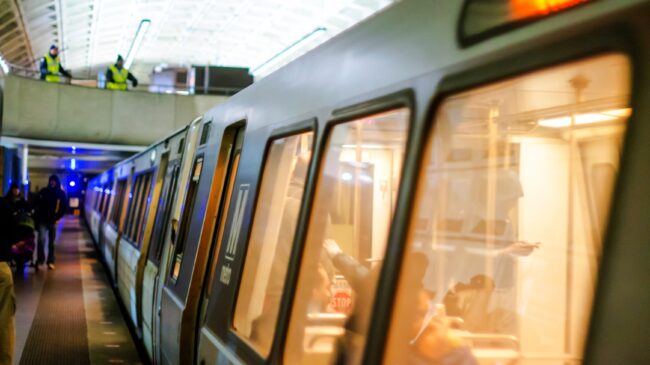Last month’s Washington Metropolitan Area Transit Authority (WMATA) derailments were the latest example of the agency’s inability to safely manage its fleets. After years of decline—in reliability, safety, and ridership—it remains clear that the Metro is ill-equipped to manage the risks that come with a rail system. Metro’s ridership has seen a steady decline since 2009 and incidences of riders being stranded, or cars being pulled for safety measures have been reoccurring issues over the last decade.
Not only has deferred maintenance from the system’s earlier years continued to present problems, but the agency’s current inventory management, procurement, recordkeeping, safety, and training problems continue to threaten the transit system’s viability.
In September, the Washington Metrorail Safety Commission (WMSC) issued a safety audit report that highlighted the 7000-series fleet of trains were experiencing uneven wheel wear (“out-of-round”). Yet the cars remained in service until one derailed three times in a single day and Metro finally removed the vehicles from service after being ordered to by the WMSC.
Metro’s September safety audit also revealed the agency lacks procedures and practices to identify, document, or correct uneven wheel wear, despite knowing about the problem for five years:
“Metrorail does not follow written criteria related to wheels out-of-round, a situation that can …lead to infrastructure damage (and) railcar damage… The out-of-round issues are particularly pronounced at this time on the 7000 Series fleet; however, Metrorail has not yet identified the root cause(s), despite first identifying the issue in 2016. This has limited corrective actions or mitigations. WMATA’s railcar reliability reports demonstrate that the 7000 Series wheels out-of-round issues have been prevalent since soon after the cars went into service.”
Metro’s auditors also found that the agency’s workforce has not been trained to perform even basic maintenance tasks on the 7000-series cars.
“Some engineers are still waiting to get 7000 Series training in areas such as troubleshooting, even though the railcars entered revenue service in 2015 — six years ago.”
While many details about the October 12th incident are unclear, the early results from the NTSB inspection indicate that wheels on the derailed car had moved outward on their axles, leading to derailments at switch locations. An NTSB press conference cited 39 derailment and other wheel assembly failures for the 7000 Series fleet in 2021 alone, up from five last year.
After the deadly Fort Totten crash in 2009, which killed nine people, Metro recognized the need to replace the 1000-series cars, because they did not adequately protect passengers in a crash. It took the agency eight more years to phase out the 1000 series. Now the WMSC, created in 2017 after D.C., Maryland, and Virginia agreed on the need for a regulator with enforcement authority, will make the decision as to when the problems with the 7000-series cars have been fixed.
While the 7000 Series is likely to return to service at some point, WMATA’s history with its newer cars does not inspire confidence. The “least reliable” (according to WMATA) 4000 series were retired due to numerous problems, and the 5000 series were retired due mostly to the arrival of the 7000 series. Metro originally planned to upgrade the 5000 cars, but instead decided to sell them. Additionally, the 6000 series was pulled late last year after a series of separations between cars. The agency is currently trying to put those vehicles back in service by the end of the year to fill some of the void left by the 7000 series’ unavailability.
As Table 1 shows, the agency relies heavily on the 7000-series cars, putting WMATA in a tight spot when it needs to take the cars out of service. Late last month, Metro had to increase headways (the time between trains) to 20 minutes on the Red Line and 40 minutes on all other lines.
Table 1: WMATA Fleet Breakdown by Series and Years of Service
| SERIES | FLEET | % FLEET | YEARS IN SERVICE |
| 1000 | 0 | 0.0% | 1976-2017 |
| 2000 | 76 | 5.9% | 1982-present |
| 3000 | 282 | 21.9% | 1987-present |
| 4000 | 0 | 0.0% | 1991-2017 |
| 5000 | 0 | 0.0% | 2001-2018 |
| 6000 | 184 | 14.3% | 2006-present |
| 7000 | 748 | 58.0% | 2015-present |
| TOTAL | 1290 | 100.0% | 1982-present |
Fleet management is a critical part of running a heavy-rail system. But with the four most recent fleet series either scrapped, pulled from commission, or forced back into service because of the wheel problems with the newer cars, WMATA clearly has major procurement and maintenance issues. It took only 14 years for the 6000 series to be pulled from operation, and six years for the 7000 series to be pulled from operation. One would hope the WMATA is looking to change its procurement process for the 8000 series to ensure the fleet has a longer lifetime.
WMATA’s procurement and maintenance procedures should maximize the lifecycle of rail cars. Going forward, WMATA should consider contracting out the procurement, maintenance, and operations of the rail system to an outside private party. Other rail systems have had success with this model as private parties are typically more willing to enter contracts where their award depends on maintaining performance and safety standards. Something public agencies are usually unwilling to entertain.
If they decided to find an outside operator, Metro would sign a detailed contract with the private party with provisions that tie pay to performance. If the private party did not live up to the terms of the contract, Metro could cancel it and rebid service. With contracted service, WMATA would feel free to prevent the operating entity from running unsafe trains, whereas running them by themselves creates a conflict between safety and reliability.
The establishment of the WMSC appears to have improved WMATA’s ability to identify problems, but that’s only the first step. If DC’s Metrorail system wants to overcome decades of issues, it must find dedicated management capable of strategic thinking and an entity to procure, operate, and maintain trains externally. Both things the agency has lacked since its inception.

